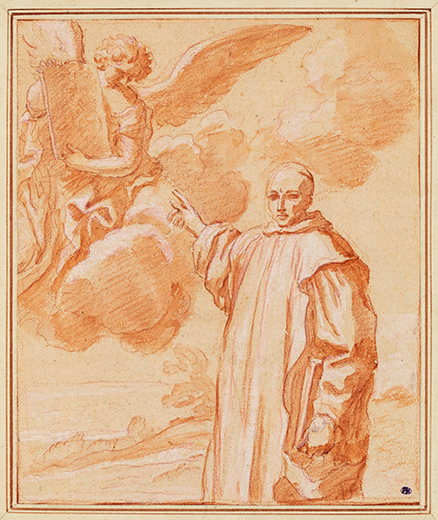Vision of Saint Bruno of Cologne 1680-1690
Giovanni Maria Morandi
* 1622 in Florence † 1717 in Rome
Red chalk, red wash, heightened with white. Size of sheet: 18.7 x 15.7 cm.
Provenance: Mathias Polakovits (1921-1987), Paris (L. 3561)
Hitherto unpublished, this modestly sized drawing is meticulously executed in Giovanni Maria Morandi’s favourite technique: red chalk elaborated with red wash and ample white heightening. The use of red wash, a technique Morandi adopted from his Florentine teacher, Giovanni Bilivert (1585-1644), eschews the need for the chalk to be densely hatched or rubbed – one may think of a Guercino drawing here – in order to achieve subtle effects of shading, while at the same time adding rich tonal variety and depth to the drawing.
Though surely intended for an altarpiece or devotional painting, no such work has yet been identified (1). The subject matter is the Vision of Saint Bruno of Cologne (c. 1030-1101), founder of the Carthusian order. Morandi depicts the saint in the order’s white habit (emphasized by the rich use of white heightening), holding a book and with the full tonsure typical of monastic orders, which makes him instantly recognizable. In earlier versions of the scene, Saint Bruno is experiencing a vision of the Virgin and Child (sometimes accompanied by Saint Peter), who hand him the rules of the Carthusian order, conferring upon him the highest approval. Daniele Crespi (1598-1630) depicted the scene thus in his vast fresco cycle dedicated to the saint’s life in the Certosa of Garegnano at Milan in 1628-29. Only five years earlier, in 1623, the cult of Saint Bruno had officially been confirmed by Pope Gregory XV (1621-23), who included the saint in the General Roman Calendar (feast day 6th October). As a consequence, the saint and his life became the subject of paintings by the foremost artists of the time, often made for one of the magnificent monasteries, called Certosa, of the Carthusian order, all of which generally adhered to a similar architectural layout. Saint Bruno was particularly revered in Naples where, in 1556 (following a devastating bout of the plague), he became the city’s second patron saint, after Saint Gennaro. The Certosa of S. Martino houses one of the most famous decorative cycles dedicated to Saint Bruno, Massimo Stanzione’s (1585-1656) paintings in the Chapel of Saint Bruno of 1633-37. A few years earlier, in 1626, Simon Vouet (1590-1650), had painted a Vision of Saint Bruno for the Certosa’s Chapterhouse (fig. XXX). His canvas depicts the Virgin and Child handing the Rules to Saint Bruno but omits the figure of Saint Peter. The narrative was subsequently further reduced in Jusepe de Ribera’s (1591-1652) small copper of 1638-43, painted for the then prior of the same Certosa and today in the museum of Capodimonte (fig. XXX): here, the Virgin is omitted, while a group of putti present the Rules to the saint. Similarly, in the most famous of all depictions of the subject, Pierfrancesco Mola’s (1612-1666) painting of circa 1660-63, today at the Getty, it is a small host of cherubs that appear to the saint in a highly dramatic landscape.
The precise date of our drawing is difficult to determine but the stylistic evidence points to the 1680s or 1690s (2). Morandi worked in Naples in 1683-86 for the church of the Gerolamini to which he contributed several altarpieces. He may well have been familiar with some of the earlier depictions of the subject, including Stanzione’s and possibly even Ribera’s. His version, however, further condensed the narrative, replacing the host of putti by a single, monumental angel holding an open book in which appears, ever so faintly, an image of the Virgin and Child. Thus, without entirely omitting the presence of the Virgin and Child, Morandi put the focus on the saint and the Rules, freed of any narrative that could possibly be perceived as distracting.
Born in Florence Giovanni Maria Morandi entered the Medici household as a young page in circa 1529. He received his early training from Sigismondo Coccapani and then from Giovanni Bilivert, whose rich red chalk drawing technique exerted a profound influence over Morandi’s. Presumably shortly after the death of his teachers (in 1643 and 1644, respectively), Morandi moved to Rome, where he entered the service of the Florentine Duca Jacopo Salviati, and remained there, with some interruptions, until his patron’s death in 1672. A sought-after portraitist, Morandi also worked intensively for the Chigi family, and in particular Pope Alxeander VII Chigi. All six popes from Alexander VII to Clement XI sat to Morandi. In 1663-67 he worked north of the Alps, in Innsbruck, and, having been called by Emperor Leopold I, at the Viennese court. His altarpieces can be found in the churches of Rome, Naples, Siena and Viterbo, among other places. Morandi entertained a large workshop with numerous live-in pupils. Among his best-known students were the Neapolitan painter Paolo de Matteis and his fellow Tuscan, Franceso Zuccarelli.
(1) We are grateful to Messr. Erich Schleier and Christoph Orth for their help in cataloguing this drawing. For a recent survey of Morandi as a draughtsman, see C. Orth, Giovanni Maria Morandi. Ein Barockkünstler in Rom, exhibition catalogue, Wallraf-Richartz-Museum, Cologne, 2015.
(2) Close in style and handling of the media is Morandi’s s Adoration of the Holy Sacrament of 1696, see Orth 2015, cat. no. 18, illustrated. In a written communication Dr. Orth suggested a dating of our sheet to the 1680s or 1690s and a likely connection with Naples.
£ 6,500.-
